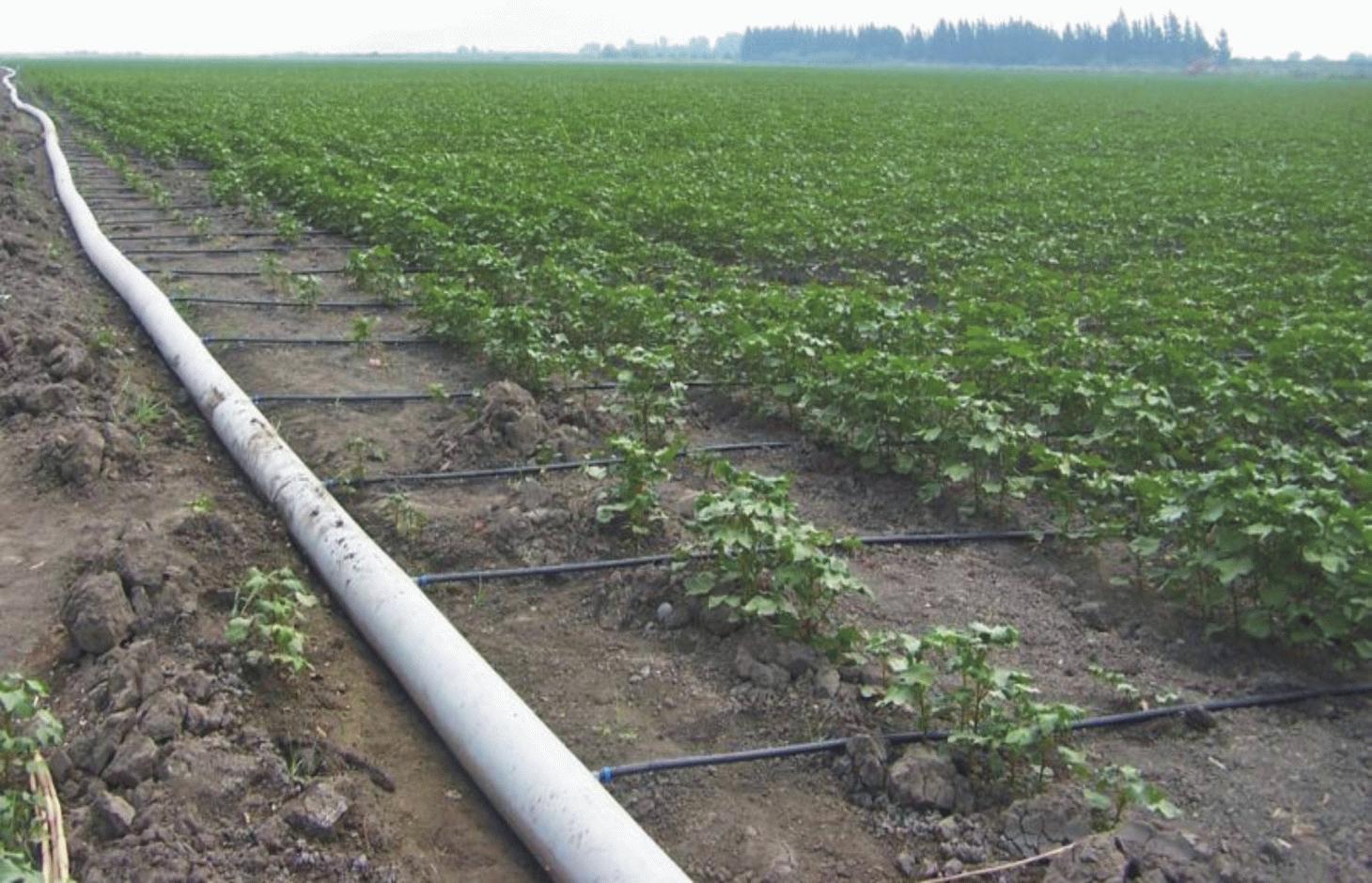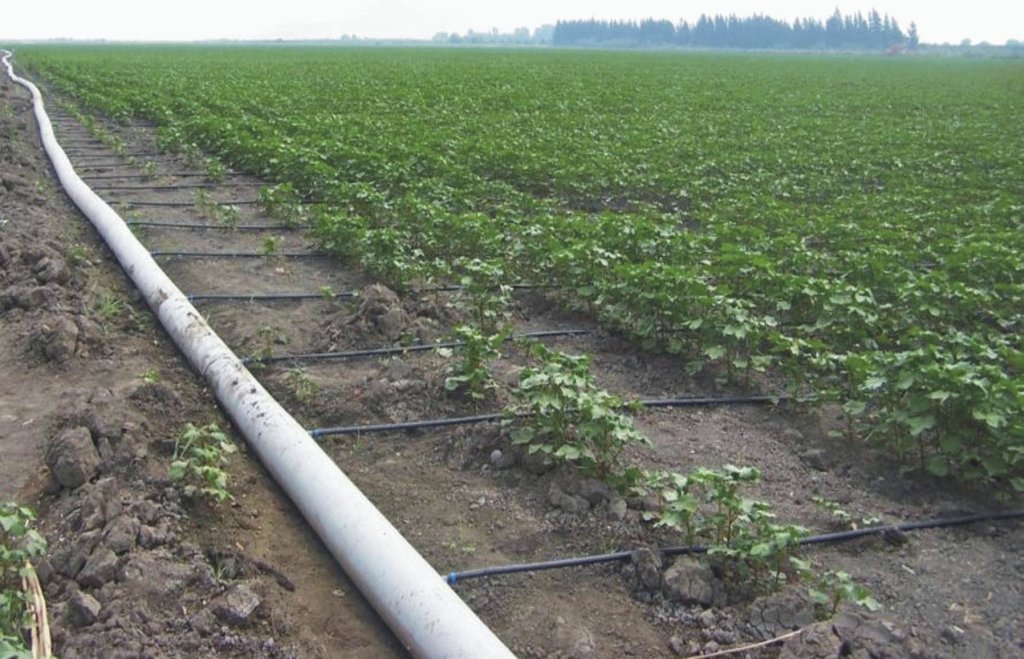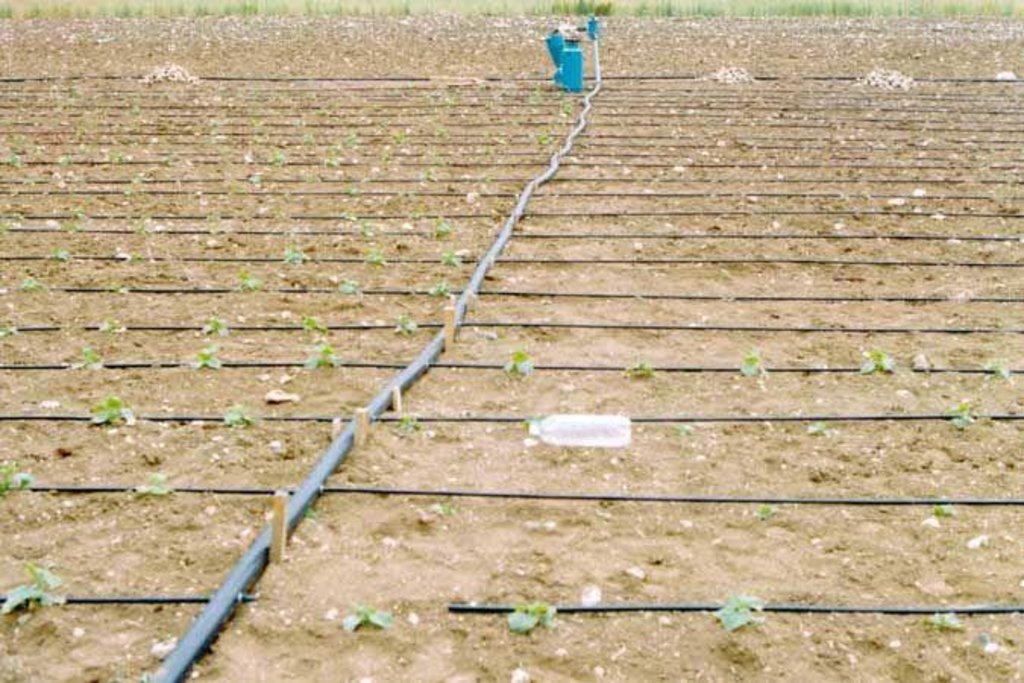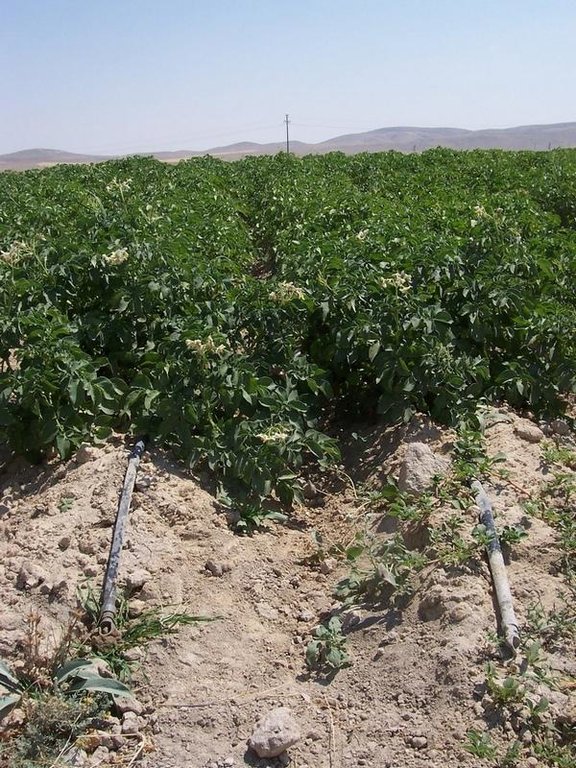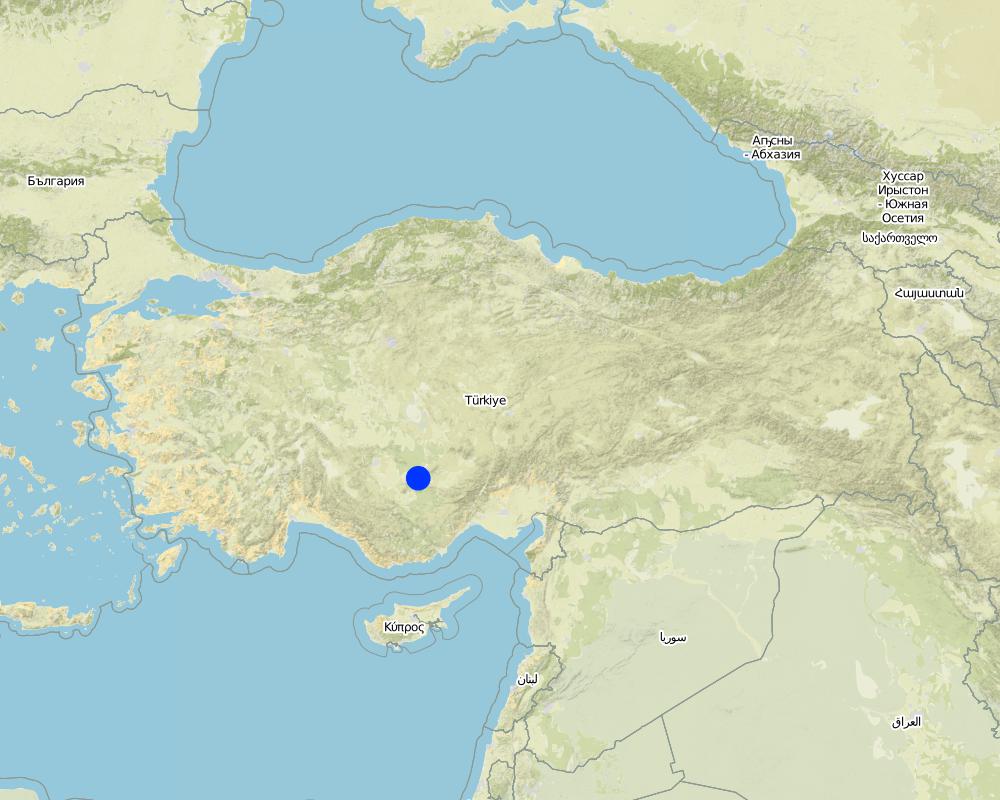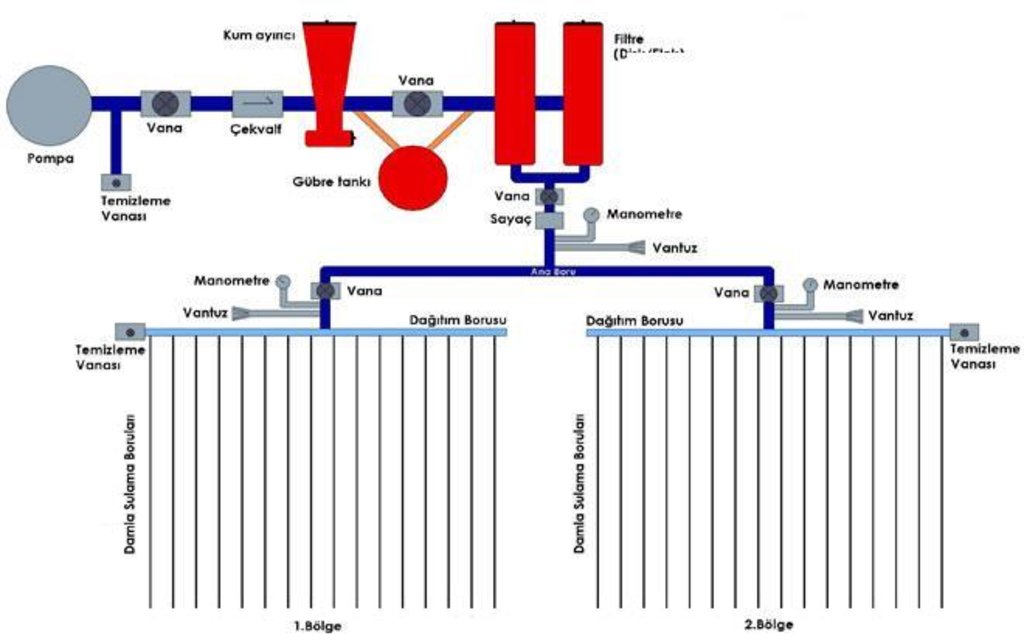Drip irrigation [Türkiye]
- Creation:
- Update:
- Compiler: Faruk Ocakoglu
- Editor: –
- Reviewers: Deborah Niggli, Alexandra Gavilano
Damla Sulama (Turkish)
technologies_1014 - Türkiye
View sections
Expand all Collapse all1. General information
1.2 Contact details of resource persons and institutions involved in the assessment and documentation of the Technology
Name of project which facilitated the documentation/ evaluation of the Technology (if relevant)
DESIRE (EU-DES!RE)Name of the institution(s) which facilitated the documentation/ evaluation of the Technology (if relevant)
University of Selcuk, Faculty of Agriculture (University of Selcuk, Faculty of Agriculture) - Türkiye1.3 Conditions regarding the use of data documented through WOCAT
The compiler and key resource person(s) accept the conditions regarding the use of data documented through WOCAT:
Yes
1.5 Reference to Questionnaire(s) on SLM Approaches (documented using WOCAT)
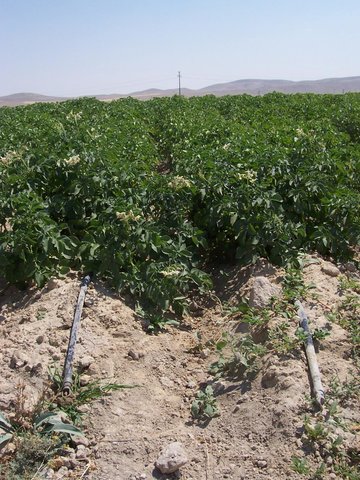
Minimum Water Use [Türkiye]
Instead of flow irrigation that requires high water consumption and causes excessive evaporation, water can be transported in pipes till crop's body and can be given slowly under controlled conditions. The approach is brought to farmers by state institutions as well as banks, and education for the scientific background, installation …
- Compiler: Mehmet Zengin
2. Description of the SLM Technology
2.1 Short description of the Technology
Definition of the Technology:
Drip irrigation is a method designed for minimum use of water and labour for the optimum irrigation of plants in arid and semi-arid regions.
2.2 Detailed description of the Technology
Description:
In drought–affected regions, fruit trees, vineyards, vegetables and other field crops such as maize, sugarbeet, potatoes, onion, etc. are watered by drip-irrigation using pipes with dripfeed points. This saves water and maximum benefit is achieved with a minimum of water. In this system, plant roots receive water at the right time and in sufficient quantities. Labour expenses with the system are low, but the first investment expenses are high. At current prices, it costs about 2000 US$ per ha, which varies with the density of the network required for the specific crop.
Purpose of the Technology: Depending on the size of the field to be watered, a main network of PVC pipes able to cope with the pressure necessary to convey water to secondary/lateral pipe systems is established. These pipes are mostly 2.5cm in diameter and have dripfeed points at their ends. The system is suitable for water conservation, because it enables watering to be focused where required, i.e. close to the root zone of the crops, but without wasting water. However, increased use in rainfed areas will increase the overall water demand. From the viewpoint of surface sealing of the soil, it has advantages since it causes wetting only in limited areas. Problems such as salinization and leaching of nutrients are also reduced by limiting the watering. At the same time, the method considerably increases farm income as excessive watering is avoided.
Establishment / maintenance activities and inputs: The basic land use types targeted with the technology are perennial tree crops (i.e. orchard and stony fruit crops) and annual crops with individual plant stems such as potato, maize and sunflower. Maize is used as fodder. It is particularly useful in arid and semi-arid regions where evapotranspiration is high, surface waters are scarce and groundwater is threatened due to high exploitation. It grows under all topographic conditions.
Natural / human environment: From the viewpoint of human environment, the technology is profitable for farmers who have a pressurized pumping system connected to a groundwater source. The basic costs are for the planning of the irrigation system, the hard PVC pipes and its set-up in the field. These services are provided by specialized companies, while the maintenance of the system can be done by the farmers themselves. The volume of the crops produced in this system is high and intended for commercial use.
2.3 Photos of the Technology
2.5 Country/ region/ locations where the Technology has been applied and which are covered by this assessment
Country:
Türkiye
Region/ State/ Province:
Konya
Further specification of location:
Karapınar
Comments:
Total area covered by the SLM Technology is 1 km2.
Map
×2.6 Date of implementation
If precise year is not known, indicate approximate date:
- less than 10 years ago (recently)
2.7 Introduction of the Technology
Specify how the Technology was introduced:
- during experiments/ research
3. Classification of the SLM Technology
3.1 Main purpose(s) of the Technology
- improve production
3.2 Current land use type(s) where the Technology is applied

Cropland
- Annual cropping
- Tree and shrub cropping
Annual cropping - Specify crops:
- cereals - barley
- cereals - maize
- cereals - wheat (spring)
- fodder crops - clover
- legumes and pulses - beans
- root/tuber crops - potatoes
- root/tuber crops - sugar beet
Number of growing seasons per year:
- 1
Specify:
Longest growing period in days: 210Longest growing period from month to month: Oct - Apr
Comments:
Major land use problems (compiler’s opinion): The main problem in the Konya closed basin is the rapidly dropping groundwater levels. For this reason electricity expenses for watering is intolerably increasing for the farmers and groundwater resources are irreversibly rapidly decreasing. Moreover, other types of watering (sprinkler and flowing) in the Karapınar area cause secondary degradation problems such as salinization and sealing.
Major land use problems (land users’ perception): This system is good for increasing crop yield and quality, and to save groundwater, but we do not know in detail how to use the system and how to fertilise with this system.
Future (final) land use (after implementation of SLM Technology): Cropland: Ct: Tree and shrub cropping
3.3 Has land use changed due to the implementation of the Technology?

Cropland
- Annual cropping
- Tree and shrub cropping
Comments:
Cropland: Ca: Annual cropping
Future (final) land use (after implementation of SLM Technology): Cropland: Ct: Tree and shrub cropping
3.4 Water supply
Water supply for the land on which the Technology is applied:
- full irrigation
3.5 SLM group to which the Technology belongs
- irrigation management (incl. water supply, drainage)
3.6 SLM measures comprising the Technology

agronomic measures
- A5: Seed management, improved varieties
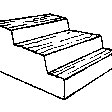
structural measures
- S11: Others
Comments:
Main measures: structural measures
Specification of other structural measures: irrigation network
Type of agronomic measures: early planting
3.7 Main types of land degradation addressed by the Technology

biological degradation
- Bc: reduction of vegetation cover
- Bh: loss of habitats
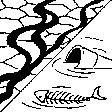
water degradation
- Ha: aridification
- Hs: change in quantity of surface water
- Hg: change in groundwater/aquifer level
- Hp: decline of surface water quality
- Hq: decline of groundwater quality
Comments:
Main type of degradation addressed: Hg: change in groundwater / aquifer level
Secondary types of degradation addressed: Bc: reduction of vegetation cover, Bh: loss of habitats, Ha: aridification, Hs: change in quantity of surface water, Hg: change in groundwater / aquifer level, Hp: decline of surface water quality, Hq: decline of groundwater quality
Main causes of degradation: crop management (annual, perennial, tree/shrub) (Plants requiring much water are grown instead of cereals, causing the water to finish.), over abstraction / excessive withdrawal of water (for irrigation, industry, etc.), population pressure (Population increasing and yield capacity is decreasing.)
Secondary causes of degradation: education, access to knowledge and support services (Lack of technical information is hindering a success farming.), governance / institutional (There is not a forcing rule/law for drip irrigation, but there is subsidizing.)
3.8 Prevention, reduction, or restoration of land degradation
Specify the goal of the Technology with regard to land degradation:
- prevent land degradation
- reduce land degradation
Comments:
Main goals: prevention of land degradation
Secondary goals: mitigation / reduction of land degradation
4. Technical specifications, implementation activities, inputs, and costs
4.1 Technical drawing of the Technology
Technical specifications (related to technical drawing):
A sufficiently powerful pump provides pressurized water into the system. Before entering the distribution pipes, the water is cleared of silt particles in the filters and fertilizers are added if needed
Technical knowledge required for field staff / advisors: high (Selection of suitable pipe types and dimeters, and drippers are importants.)
Technical knowledge required for land users: moderate (Mostly related with arranging pressure levels and fertilization equipments)
Main technical functions: water harvesting / increase water supply
Secondary technical functions: increase of groundwater level / recharge of groundwater
Early planting
Material/ species: plastic pipe with dripper.
Quantity/ density: 1- 2 /plan
Major change in timing of activities: In drip irrigation, water is given to plant root zone frequently, but low-low.
Author:
http://www.ziraialet.com/haber
4.2 General information regarding the calculation of inputs and costs
other/ national currency (specify):
turkish lira
If relevant, indicate exchange rate from USD to local currency (e.g. 1 USD = 79.9 Brazilian Real): 1 USD =:
2.0
Indicate average wage cost of hired labour per day:
25.00
4.3 Establishment activities
| Activity | Timing (season) | |
|---|---|---|
| 1. | Installation of drip irrigation system | |
| 2. | Farmers training | Spring |
4.4 Costs and inputs needed for establishment
| Specify input | Unit | Quantity | Costs per Unit | Total costs per input | % of costs borne by land users | |
|---|---|---|---|---|---|---|
| Labour | Labour | ha | 1.0 | 100.0 | 100.0 | 90.0 |
| Other | Drip irrigation system | ha | 1.0 | 2000.0 | 2000.0 | 90.0 |
| Total costs for establishment of the Technology | 2100.0 | |||||
| Total costs for establishment of the Technology in USD | 1050.0 | |||||
Comments:
Duration of establishment phase: 1 month(s)
Life span of drip irrigation system: 10 years
Number of parties (sharing): 2
4.5 Maintenance/ recurrent activities
| Activity | Timing/ frequency | |
|---|---|---|
| 1. | Change of drippers | spring |
| 2. | Change of sediment filters | spring |
| 3. | Overall cleaning of the system | random |
4.6 Costs and inputs needed for maintenance/ recurrent activities (per year)
| Specify input | Unit | Quantity | Costs per Unit | Total costs per input | % of costs borne by land users | |
|---|---|---|---|---|---|---|
| Labour | Labour | ha | 1.0 | 100.0 | 100.0 | 100.0 |
| Other | Drip irrigation system | ha | 1.0 | 200.0 | 200.0 | 100.0 |
| Total costs for maintenance of the Technology | 300.0 | |||||
| Total costs for maintenance of the Technology in USD | 150.0 | |||||
Comments:
In the calculation, it is assumed that the crop is a legume with 50 cm regular row intervals and the distance between individual plants is of the order of 30 cm.
4.7 Most important factors affecting the costs
Describe the most determinate factors affecting the costs:
The main network of hard PVC pipes, pressure indicators, main distributor, and labour force are the main costs.
5. Natural and human environment
5.1 Climate
Annual rainfall
- < 250 mm
- 251-500 mm
- 501-750 mm
- 751-1,000 mm
- 1,001-1,500 mm
- 1,501-2,000 mm
- 2,001-3,000 mm
- 3,001-4,000 mm
- > 4,000 mm
Specifications/ comments on rainfall:
Seven months are drought in a year.
Agro-climatic zone
- semi-arid
Thermal climate class: temperate
5.2 Topography
Slopes on average:
- flat (0-2%)
- gentle (3-5%)
- moderate (6-10%)
- rolling (11-15%)
- hilly (16-30%)
- steep (31-60%)
- very steep (>60%)
Landforms:
- plateau/plains
- ridges
- mountain slopes
- hill slopes
- footslopes
- valley floors
Altitudinal zone:
- 0-100 m a.s.l.
- 101-500 m a.s.l.
- 501-1,000 m a.s.l.
- 1,001-1,500 m a.s.l.
- 1,501-2,000 m a.s.l.
- 2,001-2,500 m a.s.l.
- 2,501-3,000 m a.s.l.
- 3,001-4,000 m a.s.l.
- > 4,000 m a.s.l.
5.3 Soils
Soil depth on average:
- very shallow (0-20 cm)
- shallow (21-50 cm)
- moderately deep (51-80 cm)
- deep (81-120 cm)
- very deep (> 120 cm)
Soil texture (topsoil):
- medium (loamy, silty)
Topsoil organic matter:
- medium (1-3%)
- low (<1%)
If available, attach full soil description or specify the available information, e.g. soil type, soil PH/ acidity, Cation Exchange Capacity, nitrogen, salinity etc.
Soil fertiliy is medium
Soil drainage/infiltration is good
Soil water storage capacity is medium
5.4 Water availability and quality
Ground water table:
> 50 m
Availability of surface water:
poor/ none
Water quality (untreated):
poor drinking water (treatment required)
5.5 Biodiversity
Species diversity:
- low
5.6 Characteristics of land users applying the Technology
Market orientation of production system:
- mixed (subsistence/ commercial)
Off-farm income:
- less than 10% of all income
Relative level of wealth:
- poor
- average
Individuals or groups:
- individual/ household
Level of mechanization:
- mechanized/ motorized
Indicate other relevant characteristics of the land users:
Land users applying the Technology are mainly Leaders / privileged
Population density: 10-50 persons/km2
Annual population growth: 0.5% - 1%
70% of the land users are average wealthy and own 10% of the land.
30% of the land users are poor and own 5% of the land.
Level of mechanization: Every kind of machine is used
5.7 Average area of land used by land users applying the Technology
- < 0.5 ha
- 0.5-1 ha
- 1-2 ha
- 2-5 ha
- 5-15 ha
- 15-50 ha
- 50-100 ha
- 100-500 ha
- 500-1,000 ha
- 1,000-10,000 ha
- > 10,000 ha
Is this considered small-, medium- or large-scale (referring to local context)?
- medium-scale
5.8 Land ownership, land use rights, and water use rights
Land ownership:
- individual, titled
Land use rights:
- individual
Water use rights:
- individual
5.9 Access to services and infrastructure
health:
- poor
- moderate
- good
education:
- poor
- moderate
- good
technical assistance:
- poor
- moderate
- good
employment (e.g. off-farm):
- poor
- moderate
- good
markets:
- poor
- moderate
- good
energy:
- poor
- moderate
- good
drinking water and sanitation:
- poor
- moderate
- good
financial services:
- poor
- moderate
- good
6. Impacts and concluding statements
6.1 On-site impacts the Technology has shown
Socio-economic impacts
Production
crop production
fodder production
fodder quality
risk of production failure
production area
Water availability and quality
irrigation water availability
demand for irrigation water
Income and costs
farm income
diversity of income sources
Socio-cultural impacts
food security/ self-sufficiency
health situation
Comments/ specify:
Wealth of farmers increased because of minimum water use and maximum plant production. Underground water loss stress finished in their mind.
cultural opportunities
recreational opportunities
community institutions
SLM/ land degradation knowledge
conflict mitigation
Improved livelihoods and human well-being
Comments/ specify:
Certainly the technology supplies richness, easiness and low water consumption. It supports high quality and quantity of production due to the fact that plants grow without no water or excessive water stress.
Ecological impacts
Water cycle/ runoff
water quantity
water quality
surface runoff
groundwater table/ aquifer
evaporation
Soil
soil moisture
soil crusting/ sealing
soil compaction
6.2 Off-site impacts the Technology has shown
water availability
downstream flooding
6.3 Exposure and sensitivity of the Technology to gradual climate change and climate-related extremes/ disasters (as perceived by land users)
Gradual climate change
Gradual climate change
| Season | increase or decrease | How does the Technology cope with it? | |
|---|---|---|---|
| annual temperature | increase | well |
Other climate-related consequences
Other climate-related consequences
| How does the Technology cope with it? | |
|---|---|
| very low temperature | not well |
6.4 Cost-benefit analysis
How do the benefits compare with the establishment costs (from land users’ perspective)?
Short-term returns:
negative
Long-term returns:
very positive
How do the benefits compare with the maintenance/ recurrent costs (from land users' perspective)?
Short-term returns:
very positive
Long-term returns:
very positive
Comments:
Short- & long-term benefits are very positive. But the technique is new. Not enough knowledge of this system, especially in fertigation (watering + fertilizing). First investment costs high and peolpe do not believe drip water will feed the plants.
6.5 Adoption of the Technology
If available, quantify (no. of households and/ or area covered):
580
Of all those who have adopted the Technology, how many did so spontaneously, i.e. without receiving any material incentives/ payments?
- 11-50%
Comments:
70% of land user families have adopted the Technology with external material support
290 land user families have adopted the Technology with external material support
Comments on acceptance with external material support: In recent times, the area affected reached 20%, because the Turkish Government gives credit with no interest to farmers in dry regions.
30% of land user families have adopted the Technology without any external material support
290 land user families have adopted the Technology without any external material support
Comments on spontaneous adoption: Initially, only rich farmers used this system because it is expensive.
There is a moderate trend towards spontaneous adoption of the Technology
Comments on adoption trend: The government has responded positively to this situation by giving no-interest credit for 5 years.
6.7 Strengths/ advantages/ opportunities of the Technology
| Strengths/ advantages/ opportunities in the land user’s view |
|---|
|
Ease of watering with this system How can they be sustained / enhanced? Training and subsidies. |
| Strengths/ advantages/ opportunities in the compiler’s or other key resource person’s view |
|---|
|
Minimum water use, easy using, low energy demand (fuel, electric, labour, etc.) How can they be sustained / enhanced? Subsidizing. |
|
Sufficent watering enables an increased crop yield How can they be sustained / enhanced? education regarding the watering frequency would be useful. |
6.8 Weaknesses/ disadvantages/ risks of the Technology and ways of overcoming them
| Weaknesses/ disadvantages/ risks in the land user’s view | How can they be overcome? |
|---|---|
| Drip irrigation system has a short life (1-5 years). | UV-tolerant plastic must be manufactured and used. |
| Weaknesses/ disadvantages/ risks in the compiler’s or other key resource person’s view | How can they be overcome? |
|---|---|
| Users do not know how to use this new system exactly. In particular, farmers do not know “fertigation” methods for their different plants such as maize, sugar beet, potato, and orchards. | More education and demonstration of fertigation methods by state institutions. |
7. References and links
7.1 Methods/ sources of information
7.2 References to available publications
Title, author, year, ISBN:
Kara, M., 2005. Sulama ve Sulama Tesisleri. S.Ü. Ziraat Fak. Tarımsal Yapılar ve Sulama Böl., Konya, Turkiye.Şahin, M. ve Kara, M., 2006. Konya İklim Koşullarında Farklı Sulama Uygulamalarının Çim Gelişimine Etkisi ve Su Kısıtına Yönelik Sulama Alternatifleri. S.Ü. Ziraat Fak. Derg., 20(39), 118-128, Konya.
Links and modules
Expand all Collapse allLinks

Minimum Water Use [Türkiye]
Instead of flow irrigation that requires high water consumption and causes excessive evaporation, water can be transported in pipes till crop's body and can be given slowly under controlled conditions. The approach is brought to farmers by state institutions as well as banks, and education for the scientific background, installation …
- Compiler: Mehmet Zengin
Modules
No modules


